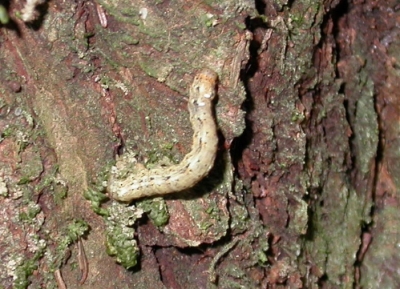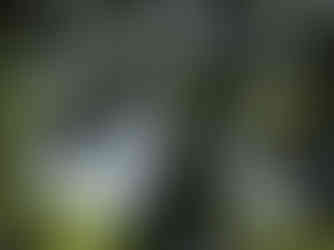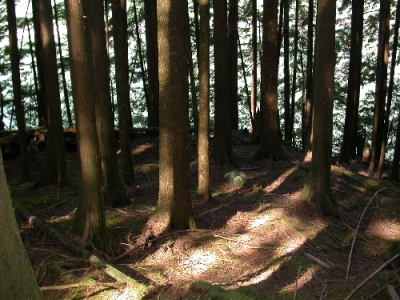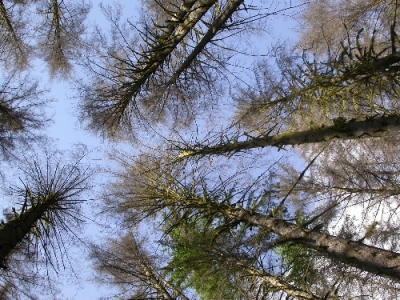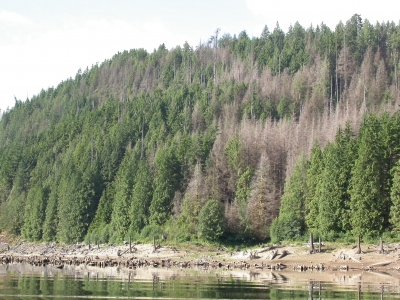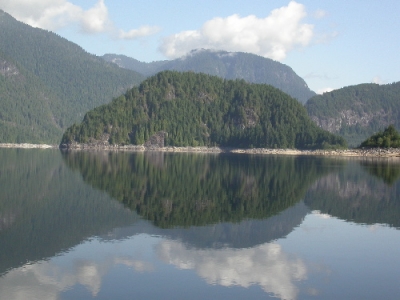Western Hemlock Looper: A biological Agent of Disturbance in Coastal Forests of British Colombia
- UBC Tree Ring Lab

- Sep 25, 2007
- 4 min read
Updated: Sep 15, 2021
Shane McCloskey (2007) Ph.D. Dissertation Department of Geography, University of British Columbia, Vancouver
Abstract
My dissertation examines western hemlock looper (Lambdina fiscellaria lugubrosa Hulst) as an agent of disturbance in coastal forests of British Columbia. Western hemlock looper populations along coastal British Columbia have undergone seven episodes of outbreak from 1911 to 2004, leading to visible defoliation of western hemlock (Tsuga heterophylla (Raf.) Sarg.)-dominated forests. My research investigates the causal factors that influence the timing of outbreaks, the impacts the resultant defoliation has on forest structure and composition, and the spatio-temporal dimensions of this biological disturbance agent.
In order to identify the specific antecedent climate conditions that contributed to western hemlock looper outbreaks between 1911 and 2003, I analyzed local meteorological records to develop a moisture stress index of combined temperature and precipitation data. This index included periods of warm, dry climate between 1895 and 2004, and I hypothesized that these warm, dry conditions would improve the survival of western hemlock looper larvae and facilitate population increases. Indeed, a high moisture stress index in June was associated with the onset of visible defoliation by western hemlock looper populations later that year. Furthermore, a high moisture stress index over the entire growing season (May to September) was associated with conditions two years before visible defoliation events, thereby providing a trigger for populations to increase to outbreak levels in subsequent years. Given predicted warmer and drier climatic conditions during the growing season in coastal British Columbia, I anticipate that the frequency of western hemlock looper outbreaks will increase in future.
To quantify the impacts of defoliation on the structure and composition of the coastal forests, I compared the effects of three different levels of disturbance severity on stands with comparable tree composition, density, age and stand structure within the Coquitlam River watershed during a western hemlock looper outbreak from 2000-2003. I hypothesized that defoliation from western hemlock looper would slow the growth of canopy western hemlocks at sites with low levels of defoliation and lead to the death of canopy western hemlocks at sites with more severe defoliation. I found that the degree of canopy openness increased with disturbance severity and resulted in an increase in understory vascular plant diversity. I suggest that these alterations to forest structure and composition will lead to an increase in the number of possible future successional pathways and increase forest heterogeneity at the landscape level.
In a second study of disturbance effects, I analyzed the temporal pattern of tree death and the resulting rates of mortality after the 2000-2003 western hemlock looper outbreak. I hypothesized that mortality of trees in defoliated areas would be influenced by tree diameter, with smaller trees more susceptible to defoliation and dying at a greater rate than larger trees. Using repeated census data, I was able to show species-specific responses in mortality following western hemlock looper outbreaks. Western hemlock had high levels of mortality across all diameter classes, while mortality of western redcedar and amabilis fir was confined to smaller trees.
To determine if the frequency of western hemlock looper outbreaks changed over the past two centuries, I employed dendroentomological methods to reconstruct outbreaks that occurred on Coquitlam Island, a 75 ha island where three outbreaks had been documented during the 20th century. I used differential rates of tree-ring growth between ‘host’ western hemlock and ‘non-host’ western redcedar to detect periods of radial growth suppression associated with western hemlock looper outbreaks using the program OUTBREAK. I used known periods of western hemlock looper outbreaks in the 20th century to calibrate and verify the reconstruction techniques. I successfully reconstructed four outbreaks over a 135-year period between 1775 and 1910. The dendroentomological method was successful at identifying low, moderate and high severity outbreaks, whereas the written record identified only periods of visible defoliation from high severity outbreaks. Based on the reconstructed outbreaks, I have determined that the frequency of defoliations has not changed significantly over the past 200 years.
RESEARCH CONTRIBUTIONS
Research Reports
Daniels, L.D., S.P.J. McCloskey, B.A. Blackwell, and P. Vera. 2004. Western hemlock looper in coastal BC: Disturbance regime and implications for Forest Management. Submitted to Forestry Innovation and Investment, Vancouver, BC. April 2004. 44p.
Conference Presentations & Posters
Forest composition and structure following defoliation by western hemlock looper.
Presented by S.P.J. McCloskey. Co-Author: L.D. Daniels. Annual Meeting of the Ecological Society of America, San Jose, CA, August 2007.
Evaluation of the role of climate in driving western hemlock looper population outbreaks. Presented by S.P.J. McCloskey. Co-Author: L.D. Daniels. Presented at Northwest Scientific Association Meeting, Victoria, BC, February 2007.
Impacts of defoliation by western hemlock looper on coastal BC forests. Presented by S. P.J. McCloskey. Co-Author: L.D. Daniels. Presentation at the Annual Meeting of the Association of American Geographers, Denver, CO, March 2005.
Impacts of Defoliation by Western Hemlock Looper on Coastal BC Forests. Presented by S.P.J. McCloskey. Co-Author: L.D. Daniels. Illustrated Poster, Annual Meeting of the Association of American Geographers, Philadelphia, PA, March 2004.
Conference Field Trips
Temperate Rainforests – Sea and Sky. Co-Presenters: L.D. Daniels, K.P. Lertzman, A.B. Stan, S.P.J. McCloskey and J. Passmore. Field Trip at the North American Forest Ecology Workshop, Vancouver, BC, June 2006.
Current Research
Shane McCloskey is now a post-doctoral researcher in the Tree-Ring Laboratory at the University of Auckland, New Zealand, studying intra-annual features of kauri (Agathis australis) tree-rings. (http://www.sges.auckland.ac.nz/sges_research/treeringlab/index.htm)
For further information, contact Dr. Lori Daniels, Department of Forest and Conservation Sciences, University of British Columbia, lori.daniels@ubc.ca

